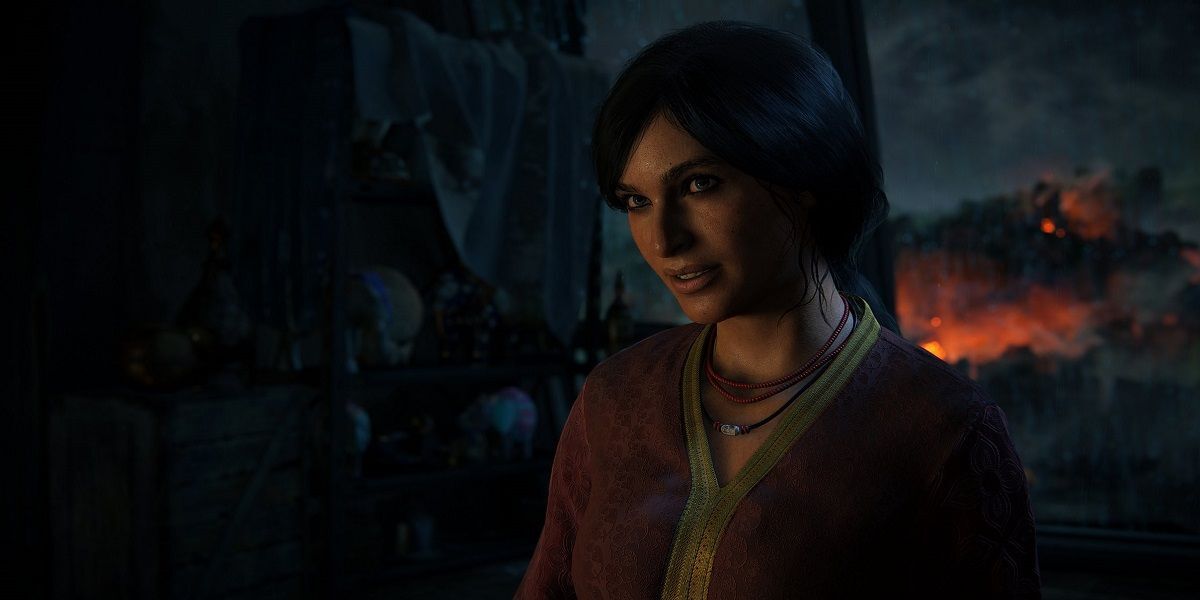Entertainment mediums in the West are introducing likable South Asian protagonists into fiction--slightly steering away from its history of brownface casting and becoming more inclusive of South Asian storytellers. Although Squid Game's Ali Abdul and Midnight Mass' Sheriff Hassan weren't the main characters of their respective stories, they were unapologetically brown, purposeful, and supported by the story. Even the imperfect desi girl Devi Vishwakumar from Never Have I Ever--whose actor also voiced Priya in Turning Red--has become a relatable character to South Asians, teens, and people recollecting their messy formative high-school years. However, representation doesn't need to be limited to solely relatable stories when something as fantastical as The Green Knight makes brown characters shine. And while other mediums are exploring what South Asian representation looks like from a variety of angles, video games are still struggling with the basics.
The term South Asian is incredibly broad--including almost two billion people across multiple countries and the diaspora--but diverse experiences that leverage the people that have lived them in their creation are a way to achieve an authentic story that avoids generalizations and typecasting. However, purposeful representation of the subcontinental people and its diaspora as protagonists remains largely absent in games. I spoke to a few South Asian game developers about their thoughts on the current state of South Asian representation in the games industry, and what it could become in the indie and AAA spaces.
"I think the indie space is leading the charge [in South Asian representation]--the game I'm currently working on with Outerloop is specifically about the South Asian experience, and the protagonist is a young South Asian woman," said Meghna Jayanth, narrative designer at Outerloop. "Brianna Lei's Butterfly Soup was the first time I felt in any way like my identity was represented in a game. Visai Games' Venba is a beautiful, grounded South Asian story of cooking and family. Indian designers are doing interesting work as well--look at the gorgeous Raji: An Ancient Epic by Nodding Head Games."

The aforementioned game by Outerloop is called Thirsty Suitors, and features spirited protagonist Jala, who embarks on her journey to better understand herself by skateboarding, cooking to impress her mother, and battling suitors and her exes throughout the game. Thirsty Suitors meshes culture into Jala's world in her life in a small town called Timber Hills.
When asked about characters in games that he's found relatable, Outerloop co-founder Chandana Ekanayake said, "In games not so much–it's one of the reasons why we're making [Thirsty Suitors]. I don't feel like there is [representation]--outside of games like Hasan Minhaj's Homecoming King, which came out in 2017 … I've been thinking a lot about this and have wanted to do more representation in games with more brown characters [since then]. That whole standup routine really hit home for me." Ekanayake, who is Sri Lankan and grew up in a small town in Maryland, mentioned how Minhaj grew up in a small town in California and found a shared experience of growing up as an immigrant.
According to Ekanayake, large companies in other entertainment fields may showcase brown characters to reach a broader audience, but authenticity comes from the writers and creators behind the stories. Never Have I Ever, for example, was created by Mindy Kaling and as a result "it's obviously from a point of experience, the point of view from someone that's lived through it or understands the culture more than just to expand an audience on screen."
Raj Patel, senior brand manager at Relic Entertainment, said he feels like South Asian characters in games are included as an afterthought, and that while we might be seeing more South Asian faces, there is very little beyond this. "You'll see a character that looks South Asian, but we're not seeing South Asian stories or characters, which is both good and bad." Patel said."You don't want to have that every time there is a South Asian, they have to be playing a South Asian character--like speaking to South Asian stories specifically: Normalize it, normal characters can just be South Asian, but you want to go a step further and sometimes see your stories being told."
Furthermore, even how South Asian faces are presented can be extremely limited. Patel shared an experience where he noticed early concept art having a hijabi character get cut out through the development process on a previous AAA project. "Later down the road I would see [the character] get cut quietly, no one would say it was cut--you just see it not appearing anymore. Then you would ask around, and someone would say something like, 'Oh there are technical reasons,' or something like that, and it's not true because you'll see an earlier prototype where it was actually working."
This isn't to say, however, that there aren't other games merging intricate narratives and South Asian representation together. Ekanayake mentioned the narrative cooking game Venba, which he finds both narratively and mechanically interesting because "It's about this immigrant mother who moved to Canada, and this game is about cooking and reconnecting with your culture. Even though you're not from that culture I feel like there’s still a sort of universal truth there about reconnecting with where you come from," Ekanayake said.
Abhi, a designer at Visai games working on Venba, indicated that appealing to the South Asian demographic specifically can be a tricky prospect in big-budget video games. "I feel that it's hard to have a carefully developed anything in AAA. As the saying goes, 'When a measure becomes a target, it ceases to be a good measure.' I can't imagine a giant production prioritizing this unless it feels it's a target to hit. In which case, it's even harder for me to imagine something like this leading to a portrayal that's not tokenized or skin deep."

Currently, well-known South Asian characters in AAA games are predominantly limited to player versus player games where the story and character development aren't a core part of the game experience and are instead something that players usually need to do a little extra legwork to experience. In Overwatch, for example, there's the Indian character Symmetra, and the game also includes a map set in Nepal. However, Symmetra's story isn't included in the game in a meaningful way. Of course, this is the nature of modern multiplayer-only games, and the same is the case in Respawn's Apex Legends' Rampart, another Indian character who, like Symmetra has her story told largely has her story told outside of the game
Regarding Symmetra, Ekanayake said, "Exploration of the character is as deep as the game mechanics allow you to do, and Overwatch being a primarily multiplayer shooter, the only way you'd get some of that is through what she says after a kill or before a kill, or mostly through the cinematic introduction. That's where you end up getting most of the cultural relevance of the character." He further explained, "Games [can] explore more than shooting as the main mechanic--that's why with Uncharted games or Last of Us games, you get attached to those characters, because there are moments of character development between the characters and storytelling that's allowed. Mechanically you're still killing things in [those] games but in between the moments of killing things, there is some character development and storytelling that happens."
Essentially, players aren't pushed to form a deeper connection with a character in PvP games like they would be in a story-driven game. But even in stories where storytelling is a key focus, depictions of South Asian characters can very easily become faulty without South Asians being involved in telling them. Jayanth, who delivered a keynote at DiGRA India on white protagonists in game design, said, "One of the injunctions of white protagonism that I discuss is: The white protagonist does not see race, nor goes the game 'see' the white protagonist through the lens of race. Unless the AAA games industry rethinks the very notion of protagonism, it will be limited in how it portrays South Asians and non-white people in general."
Chloe Frazier, who was introduced by Naughty Dog in Uncharted 2, is a half-Indian and half-Australian character. However, her Indian identity wasn't revealed until it became convenient for the story of the standalone expansion called Uncharted: Lost Legacy--which released eight years after the second installment of the Uncharted series. Frazer, voiced by a white person, starred as one of the two protagonists. Even the credits didn't list a single South Asian writer on the narrative team, unsurprisingly leading to the game's exoticized plot. I came across mentions of South Asian advisors and consultants for Lost Legacy's elephant riding scene or doing yoga poses, but brown people shouldn't just exist to correct the white developer's vision when culturally-knowledgeable environmental artists and animators could lead the way.
"I think Uncharted: Lost Legacy feels troubling to me," Jayanth said. "It's technically extremely beautiful, and so intensely researched. It's set in South India--there are marketplace scenes in the early games which feel very true, the languages spoken, colors, clothes, atmosphere all meticulously authentic, but the game portrays a South India where the military occupies the streets of metropolises and there are check-points everywhere. There are insurgents who are hoping to tip the country into civil war. While this would make sense in Kashmir, it makes no sense in South India. It's not clearly an alternate universe, and it feels no need to explain itself--to play this as an Indian is extremely disconcerting. It is also to feel painfully aware that a civil war in South India is not something that needs explanation to the imagined player of the game, a white player, an American player." Kashmir is the northmost region in South Asia, bordering India, Pakistan, and China. Its civilians have been rattled by militarized violence due to imperialist goals from neighboring regions.

She added, "The culture and geopolitical realities of India are just set-dressing for this story of adventure. India is so 'other' it may as well be a fantasy--this is the very foundation of orientalism, which is still alive and well. In fact, I saw a lot of critical appreciation of Lost Legacy for its authentic portrayal and almost no mention of the baffling military occupation of Chennai." Ekanayake, meanwhile, didn't seem to find much of a connection to this game or character either, saying Lost Legacy "kind of mentions Sri Lanka and [that] this was taking [place] somewhere in India, and there's some war going on--I don't know what war that was--but it was kind of there and sort of not there."
The attachment of brown characters to the struggles of fictional wars doesn't end there. Previous Call of Duty games had maps set in war-torn Pakistan and Afghanistan--regions that don't get much attention outside of a military setting in video games. Jayanth brought up Call of Duty: Vanguard character Padmavati Balan, saying that using South Asian characters within the confines of stories about war "reveals the limits of the concept of representation."
"Is being represented by an imperial war simulator something to be desired?" Jayanth said. "Call of Duty is deeply enmeshed in Anglo-American imperial logic, full of fantasies of noble war and worlds transformed by white men with guns and industrialized killing. Padmavati's backstory as a fighter against the British Empire is set dressing and makes Call of Duty marketable to a huge Indian audience without, in any way, committing to anti-imperialism or a genuine critique of the empire beyond the most gestural."
Vanguard lacks an understanding of India's current social structures, as well, and as a result, it becomes "a troubling fantasy to offer to Indian and diaspora players at a time where India is in the grip of an increasingly authoritarian and fascistic Hindutva nationalism, which is always accompanied by a fetishization of military power. In that light, it's certainly interesting that the South Asian character in Call of Duty isn't Muslim," Jayanth said. Even Raji: An Ancient Epic--an action-adventure developed by an Indian studio that knows the Hindu mythos--leans into the Hindutva perspective according to Waypoint. Although the developers haven't overtly cited Hindutva inspiration, it's something to be cautious of since Indian Prime Minister Narendra Modi--who champions Hindutva nationalism--encouraged India's video game industry to tell Indian folk tales and culture.
The change that needs to happen, according to Patel, is a genuine and consistent interest in representation that comes from those that aren't marginalized and are in positions to ensure that games reflect reality more accurately.
"Non-marginalized people, even if they care, have to actively care," Patel said. "They have to make an effort to represent marginalized people, and I think that's why we don't see it as much. They might be sympathetic, they might talk to us and even understand us, but if I want a character to be non-white in a video game in the past, I'd have to push for it… I think as we see the industry grow, and South Asian and Middle Eastern game developers rise in it--if they rise in it--you'll start to see that improve. I think as the leadership in games starts to become more diverse, we'll grow past that to see people not just trying to represent themselves, but understanding the value of showing more people having diversity."

Ekanayake explained that diversifying who is in leadership roles and funding projects can enact positive change for better representation. "Until we have more women and people of color in leadership roles, you're not going to see a lot of risks being taken--especially for AAA games because the budgets are so much bigger, and marketing, and expectations of trying to appeal to as many people as possible--inherently there's going to be less controversial subjects, themes or characters. They don't think it will be as marketable," he said.
Jayanth added, "There are few precedents for South Asian characters, stories, design thinking, and games development--especially when money and publishers and corporate interest are involved--in a risk-averse space. A huge barrier the industry faces is a deep-rooted notion that white players--who are still considered the core audience--will be reluctant to inhabit a racialized protagonist." She added, "Another barrier is the overwhelming whiteness of the games industry, specifically in key decision-making positions. In my opinion, the industry, its processes, and its fundamental ideas of what makes an interesting protagonist and what constitutes agency will have to be transformed for us to design truthful and interesting South Asian protagonists."
Abhi, meanwhile, wants to see change within the South Asian subcontinent itself, explaining, "The number one thing I'd like to see is more gaming studios emerge from South Asian regions. This is where my focus is currently. I would like to see the big consoles try to make the process of making and publishing a game as accessible as possible. Steam recently ran an Indian Harvest Festival event, which was really cool to see."
"There are a lot of exciting initiatives and game jams that have started to happen in South Asia, which is fantastic," he continued. "But even the cost of a next-gen console devkit can be a giant wall to climb for a studio there. Many studios are set up to do porting and other supporting development, but they also hope to make their own games at some point."
Abhi's concern, however, is that in the modern landscape of technology and development "the big companies pushing crypto/metaverse will view South Asia as a source of cheap development labor that can be utilized to build these experiences fast. Since these are technically interactive experiences--it's worrying to think established companies will incentivize existing game dev labor in South Asia to work on metaverse/crypto games, veering them away from traditional game development."
Patel also wishes to see changes happen in South Asian communities. "You know the cliche of, 'Oh you need to be a doctor, lawyer, or an engineer,' a lot of times that's coming from a place of parents not understanding. They think those are just safe options because they don't know what else is a safe option for their kids, and it helps when kids and parents can see that there are successful people in video games and that's a viable path."
Games like Thirsty Suitors and Venba center on South Asian identity while highlighting struggles relatable to many gamers without relying on clichéd perspectives. The South Asian diaspora and developers in the subcontinent should have opportunities to tell their stories, develop environments, design characters, lead, and incorporate entire teams of South Asians to work on projects--be it at a small studio or in a big-budget game.


Log in to comment